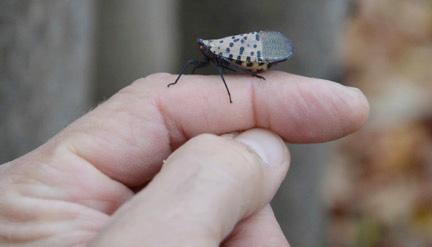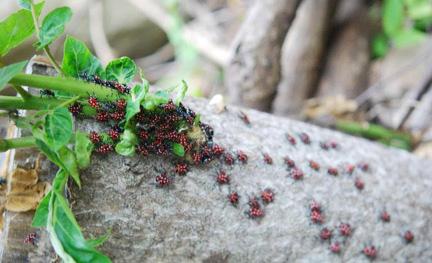INSECT HOT TOPICS: Spotted lanternfly
by James A. Bethke
This column focuses on insects that pose a threat to the ornamental plant production industry and have good potential for invasion and establishment in California.
Often one of my colleagues will warn us of a new invasive pest and a potential threat to the movement of ornamental plants if found in a nursery or other type of production site. Dan Gilrein from Cornell University in New York sent a notice to colleagues a while back about the spotted lanternfly, Lycorma delicatula (White). This invasive pest is not a fly but a type of planthopper (Hemiptera: Fulgoridae), which means it’s another one of those insects with piercing-sucking mouthparts that can seriously damage various crops. Obviously, a find of spotted lanternfly in California would require a regulatory response and would likely cause quarantine and significant impacts on the movement of nursery stock. The spotted lanternfly is native to China, India and Vietnam, and it was introduced into Korea where it has become a major invasive pest. These insects have found their way to Pennsylvania and have spread to four counties. Although not in California yet, the spotted lanternfly is likely to make it here using methods similar to the gypsy moth because they lay their eggs on all kinds of things that can be transported. For instance, eggs can be found on firewood or wood products, brush or yard waste, remodeling or construction materials and waste, packing material like boxes, grapevines for decorative purposes, nursery stock and any outdoor household articles like lawnmowers, grills, tarps and other equipment, trucks or vehicles typically not stored indoors. This insect attacks many hosts including grapes, apples, stone fruits and other fruit tree crops, grapes (wild grapes too) and ornamentals such as, lilac, poplar, maples, walnut, oak, pines and roses. They are showing a preference for egg laying on tree of heaven (Ailanthus altissima), which is common in Southern California and can be used as a sentinel plant to monitor this species (Dara et al. 2015).
The spotted lanternfly is a relatively large insect at about an inch long, and it is red and white spotted (fig. 1). They aggregate on tree bark (fig. 2). Egg masses, containing 30 to 50 eggs deposited in 4 to 7 columns about an inch long and covered in yellowish-brown waxy deposits, adhere to flat surfaces. The first three instars have a black body and legs with white spots. The fourth instar retains the spots but has a reddish body with distinctive red wing pads.


Adults and nymphs feed on the phloem of young stems and bark and excrete large quantities of honeydew. They often aggregate and feed in groups causing a nuisance in parks and urban areas. Extensive feeding results in oozing wounds on the trunk and wilting and death of branches. Significant honeydew and sootymold deposits can be found around the base of trees. As with other honeydew producers, they attract ants.
Be on the lookout for this pest. It should be quite obvious when you see them and, as with other invasives, we’d like to detect this one early if we can.
James A. Bethke is County Director and Farm Advisor for Nurseries and Floriculture, UC Cooperative Extension, San Diego and Riverside Counties.
References
Dara, S. K., L. Barringer, and S. P. Arthurs. 2015. Lycorma delicatula (Hemiptera: Fulgoridae): A new invasive pest in the United States. J. Integ. Pest Mngmt. 6(1): 20. http://jipm.oxfordjournals.org/content/6/1/20.
Penn State University. Spotted Lanternfly. http://extension.psu.edu/pests/spotted-lanternfly.
Pennsylvania Pressroom. Spotted Lanternfly Now Found In Portions of Four PA Counties. http://www.media.pa.gov/pages/Agriculture_details.aspx?newsid=364.
Ricciuti E. Be prepared for the invasive spotted lanternfly, entomologists warn. Entomology Today. Entomological Society of America. http://entomologytoday.org/2015/12/17/be-prepared-for-spotted-lanternfly/.












